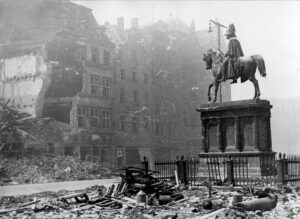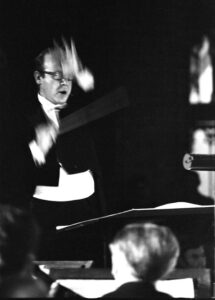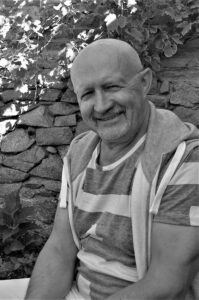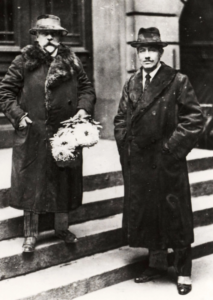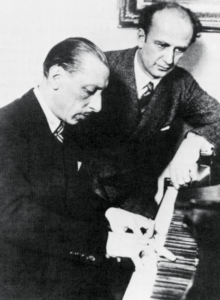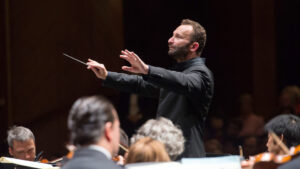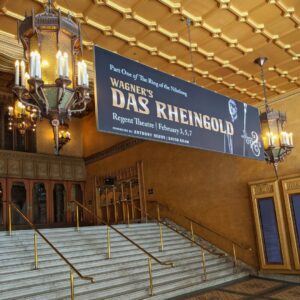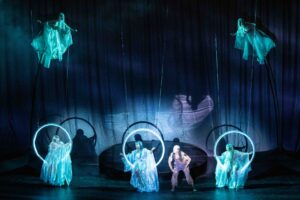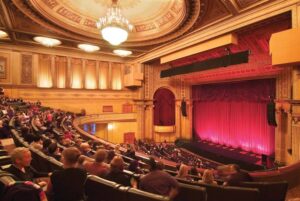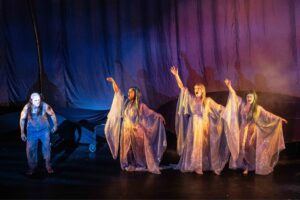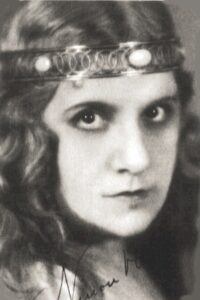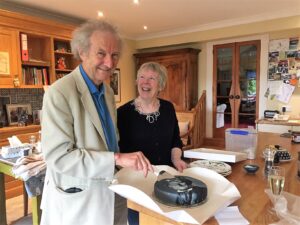O mieście, które przeżyło
Są takie dni w życiu Upiora, że nie ma ochoty ani się odnosić do bieżących wydarzeń, ani udawać, że idzie ku lepszemu, ani po raz kolejny uciekać w archiwalia. Ostatnio zaczęłam porządkować wpisy z początków istnienia strony: kiedy się przekonałam, że sporo linków w zakładce „Prasówka” wygasło i trzeba pracowicie rekonstruować teksty „znikinięte” z sieci. Przy okazji natrafiłam na esej z połowy 2014 roku i do tej pory nie mogę sobie przypomnieć, na czyje zamówienie i z jakiej okazji powstał. Ważne, że dotyczy miasta przeze mnie uwielbianego, gdzie od kilku lat dzieją się rzeczy, oględnie mówiąc, niepokojące. W polityce, w administracji, w kulturze, w samych ludziach. Przed ślepym uczuciem do Wrocławia od dawna przestrzega mnie Rafał Augustyn, rodowity wrocławianin, zakochany w swej małej ojczyźnie jak wariat. Cóż poradzić – kochamy i już. W tym artykule piszę o stolicy polskiego Dolnego Śląska i związanych z nią muzykach z prawdziwą miłością. Mam nadzieję, że wkrótce to uczucie na powrót rozkwitnie – do Wrocławia, do Warszawy, do całej Polski, do naszych rodaków, z których jedni odsłaniają teraz najpiękniejsze strony osobowości, innym zaś, jak u Przybory, fasada rozwala się z trzaskiem. Potrzebujemy otuchy jak kania dżdżu. Długa jeszcze droga przed nami.
***
Siedemset tysięcy cywilów zmuszonych przez władze III Rzeszy do natychmiastowego opuszczenia miasta – pieszo, w kompletnym chaosie, w styczniowe mrozy, które tamtego roku dochodziły do minus trzydziestu stopni. Niemieckie wyburzenia poprzedzające szturm wojsk radzieckich, blisko trzymiesięczne działania zbrojne podczas oblężenia Festung Breslau, po kapitulacji – umyślne podpalenia całych dzielnic, których szczątki tliły się później miesiącami. Prawie sto tysięcy ofiar wśród ludności, tysiące samobójstw. Siedemdziesiąt procent substancji miejskiej zniszczone. Osiemnaście milionów metrów sześciennych gruzu.
Polacy, ściągani po wojnie do Wrocławia dosłownie zewsząd – nie tylko z Kresów, ze Lwowa, spod Stanisławowa i Wilna, ale też z Wielkopolski, z Łodzi, z kielecczyzny, ze zrujnowanej w powstaniu Warszawy – z początku nie chcieli tu mieszkać. Zastali piekło dogasających pożarów, pustynię pozbawioną wody, ziejące pustymi oczodołami domy bez gazu i elektryczności. Obce miasto, Die fremde Stadt, włączone do Polski decyzją konferencji poczdamskiej. Nie wierzyli, że Wrocław będzie kiedykolwiek polski. Bali się, że i tak go utracą. Zaczęli odniemczać, repolonizować, układać sobie życie, jak umieli, odbudowywać miasto po swojemu, często z opłakanym skutkiem. Kochali, nienawidzili, karmili się nadzieją i niepewnością. Przyzwyczajali się. Tęsknili. Babka mojego przyjaciela, ilekroć prowadziła go na spacer nad Kanał Różanka, porównywała jego mętną wodę z wartkim nurtem Niemna.
Pomnik Fryderyka Wilhelma III na zrujnowanym Rynku wrocławskim. Maj 1945 roku. Fot. fotopolska.eu
Trzeba było kolejnych pokoleń, żeby nowi wrocławianie zaczęli zapuszczać korzenie w swoim mieście. Wielu lat, żeby na gruzach Festung Breslau wyrosło miasto młode, dynamiczne, gotowe do podjęcia dialogu, godzące się powoli z własną przeszłością, przede wszystkim jednak otwarte na przyszłość. Trwało długo, ale się stało. Podobnie długo trwało odbudowanie pozycji Wrocławia jako znaczącego ośrodka muzycznego. I raczej nie jest dziełem przypadku, że okres wielkich przemian z życiu koncertowym, przypadający na lata sześćdziesiąte ubiegłego wieku, zbiegł się z dorastaniem pierwszego pokolenia ludzi urodzonych w tym mieście. Trudno też się dziwić, że tak wyjątkową pozycję zyskała w nim muzyka współczesna – pozwalająca oswoić „obcy” Wrocław świeżym językiem dźwięków, otworzyć się na całkiem inny model odbioru, z braku emocjonalnych powiązań z miejscem i jego historią zbudować narrację tożsamościową w czasie teraźniejszym.
Pierwszą poważną próbę oznaczenia Wrocławia na mapie muzyki współczesnej podjęto jeszcze w czasach, gdy Filharmonię Wrocławską prowadził Radomir Reszke, dyrygent, instruktor ruchu amatorskiego, od 1956 roku pedagog tutejszej Państwowej Wyższej Szkoły Muzycznej. W roku 1962 – we współpracy z kołem terenowym Związku Kompozytorów Polskich i przy współudziale dwóch twórców, Tadeusza Natansona i Ryszarda Bukowskiego – powołał do życia Festiwal Muzyki Kompozytorów Ziem Zachodnich. Był to trzeci z kolei w kraju przegląd cykliczny dorobku twórców muzyki najnowszej, po zorganizowanej na fali odwilży 1956 roku „Warszawskiej Jesieni” i nieco młodszej „Poznańskiej Wiośnie Muzycznej”. Impreza, programowana z początku przez komisje wyłonione z grona ZKP i lokalnych muzyków, w 1964 roku objęła swym zasięgiem kompozytorów z całego kraju i odtąd odbywała się pod nazwą Festiwal Polskiej Muzyki Współczesnej. Rok później, wraz epokową zmianą na stanowisku szefa Filharmonii, zyskała kierownika artystycznego z prawdziwego zdarzenia i w krótkim czasie awansowała do rangi jednego z najciekawszych wydarzeń muzycznych w kraju, nie tylko w dziedzinie twórczości najnowszej. Zanim jednak wrócimy do historii Festiwalu, który z biegiem lat przeżył niejeden kryzys i niejedną metamorfozę, zatrzymajmy się chwilę przy Andrzeju Markowskim.
Markowski był muzykiem tak wybitnym, postacią tak złożoną, że kontynuatorzy jego muzycznych inicjatyw gubili się czasem w natłoku zostawionych przezeń tropów, nie potrafili złożyć ich w spójną całość, szukali tak długo, aż wszczęta w latach sześćdziesiątych rewolucja rozlała się w kilku niezależnych od siebie nurtach. Objąwszy w 1965 roku kierownictwo Filharmonii Wrocławskiej – po rozlicznych perypetiach natury formalnej – Markowski rozpoczął pracę niejako u podstaw, od reorganizacji orkiestry i radykalnego poszerzenia jej repertuaru, z jednej strony o traktowaną wciąż jeszcze po macoszemu muzykę dawną, z drugiej o muzykę współczesną, którą propagował z najszczerszym przekonaniem i z głębokiej potrzeby estetycznej, nie ze względów koniunkturalnych, co było udziałem wielu ówczesnych dyrygentów, traktujących twórczość najnowszą w kategoriach swoistego przymusu dziejowego. Żeby zapewnić swojemu zespołowi idealne warunki do pracy, tytanicznym wysiłkiem doprowadził do wybudowania nowej siedziby Filharmonii, otwartej 17 grudnia 1968 roku, funkcjonującej do dziś w gmachu przy Piłsudskiego. Obchody Tysiąclecia Państwa Polskiego wykorzystał nie tylko jako okazję do zorganizowania pierwszego Festiwalu Oratoryjno-Kantatowego „Wratislavia Cantans”, ale i założenia filharmonicznego zespołu kameralnego „Cantores Minores Wratislavienses”, którego kierownictwo złożył w ręce doświadczonego chórmistrza Edmunda Kajdasza. Nie zrezygnował przy tym z dalszego organizowania Festiwalu Polskiej Muzyki Współczesnej, z drugiej zaś strony – wzbogacił formułę Dni Muzyki Organowej o repertuar klawesynowy. Wprowadził orkiestrę Filharmonii Wrocławskiej na estradę „Warszawskiej Jesieni”, odbył z nią pierwsze zagraniczne podróże koncertowe z prawdziwego zdarzenia.
Andrzej Markowski dyryguje jednym z koncertów „Wratislavii”, rok 1971. Fot. bach-cantatas.com
Źródłem sukcesu „Wratislavii” było zogniskowanie koncepcji festiwalu wokół problematyki ludzkiego głosu – swoistego pomostu, łączącego w najnaturalniejszy z możliwych sposób pozornie nieprzystające do siebie estetyki i modele wykonawstwa. Markowski ostrożnie godził wodę z ogniem: od samego początku starał się organizować koncerty muzyki dawnych epok w zabytkowych wnętrzach, muzykę współczesną wprowadzając w przestrzenie niejako z definicji kojarzone z duchem modernistycznej odnowy – do Dużego Studia Polskiego Radia, do Galerii BWA, do nowego gmachu Filharmonii. Stworzył formułę pojemną, nowatorską w kategoriach nie tylko polskiego życia koncertowego, pozwalającą zaszczepić we wrocławskich melomanach świeży model odbioru wszelkiej muzyki, i tą przewrotną metodą otworzyć ich na doznanie „obcego” świata współczesności.
Pisałam niegdyś na łamach „Muzyki w Mieście”, że Markowski „wprowadził mnie w świat awangardy, i to tak skutecznie, że nigdy później nie czułam się w obowiązku stawać w jej obronie tylko dlatego, że jest awangardą”. Że założyciel „Wratislavii” miał instynkt nieomylny, bo u sedna jego umiłowania muzyki współczesnej tkwił solidny warsztat kompozytorski, doświadczenie w pisaniu muzyki użytkowej, pionierskie dokonania w dziedzinie kształtowania relacji między sferą dźwiękową a innymi elementami dzieła filmowego, teatralnego, wizualnego wreszcie. Wspomniany instynkt uchronił Markowskiego przed propagandowym terrorem modernizmu, pozwalając z morza powstającej wówczas muzyki wyłowić prawdziwe perły: wczesne próby Pendereckiego, utwory Serockiego, Góreckiego i Szalonka, nie wspominając już o kompozycjach Lutosławskiego, którego wielkość na pewnym etapie kariery owocnie współtworzył. W pierwszych latach istnienia „Wratislavii” holistyczna wizja Markowskiego rzutowała na model odbiór muzyki XX wieku w całej Polsce – to on miał odwagę, już w drugiej odsłonie festiwalu, w 1967 roku, zestawić Stabat Mater i Pieśń o nocy Szymanowskiego z Mszą h-moll Bacha, Nieszporami Monteverdiego (pod własną batutą) i Pasją Łukaszową Pendereckiego (pod dyrekcją Henryka Czyża, w kanonicznej obsadzie z Leszkiem Herdegenem, Stefanią Woytowicz, Andrzejem Hiolskim i Bernardem Ładyszem). Współczesność po raz pierwszy stawiła czoło historii, ujawniła głębię uwikłania w kontekst, zrzuciła maskę obcości.
Godnym, choć już nie tak wizjonerskim następcą Markowskiego okazał się Tadeusz Strugała, który w kolejnych latach rozszerzał formułę festiwalu o muzykę etniczną i muzykę religijną spoza europejskiego obszaru kulturowego, wzbogacił też jego program o sesje naukowe, pokazy filmowe i rozmaite inicjatywy edukacyjne. Oblicze muzyki współczesnej zaczęło się jednak odrobinę rozmywać w tym natłoku wydarzeń, twórczość najnowsza straciła pozycję równorzędnego partnera, za kolejnych szefów artystycznych (Ewa Michnik, Mariusz Smolij i Jan Latham-Koenig za dyrekcji generalnej Lidii Geringer d’Oedenberg; Paul McCreesh i Giovanni Antonini za obecnej dyrekcji Andrzeja Kosendiaka) odsunięto ją na dalszy plan, kładąc większy nacisk na dorobek epok minionych, niejako „naturalnie” kojarzony z pierwotnym założeniem „Wratislavii” jako festiwalu muzyki wokalnej i wokalno-instrumentalnej. Współczesność, śmiałym zamachem batuty wyciągnięta z cienia przez Andrzeja Markowskiego, wyrosła, zmężniała i przestała się mieścić w ramach wrześniowego festiwalu. Co nie oznacza, że znikła zeń zupełnie, niemniej palmę pierwszeństwa w tej dziedzinie przejęły inne wrocławskie imprezy.
I tym sposobem wracamy do Festiwalu Polskiej Muzyki Współczesnej, który po Markowskim – w ustalonej przez niego formule – przejął w 1969 roku Tadeusz Strugała, z początku korzystający ze wsparcia komisji repertuarowej, od roku 1974 programujący imprezę samodzielnie. Choć ówczesny prezes ZKP Józef Patkowski wyraził szczery podziw dla „rozmachu działania, ambitnych zamierzeń i bezbłędnych realizacji” polskich utworów XX-wiecznych, Strugała podkreślał, że zespół Filharmonii Wrocławskiej „wykazuje szczególne upodobania do romantyzmu i najlepiej ten styl wyczuwa”. Nowy szef dokonał rzeczy wielkich: wpisał „Wratislavię” na listę Europejskiego Stowarzyszenia Festiwali Muzycznych w Genewie, ugruntował poziom orkiestry symfonicznej, zainicjował powstanie orkiestry kameralnej „Leopoldinum”. Jego mistrzowskie interpretacje muzyki współczesnej – m.in. dzieł Palestra, Bacewicz, Kilara, Maciejewskiego – trzymały się jednak pół kroku za ukochanym klasycyzmem wiedeńskim i bogatą spuścizną XIX-wieczną. Drzwi otwarte na oścież przez Markowskiego znów jakby się zatrzasnęły. Teraźniejszość została po drugiej stronie i trochę się bała zapukać.
Zrobiła to dopiero za kadencji urodzonego już we Wrocławiu Marka Pijarowskiego, w chwili objęcia stanowiska w 1980 roku przez najmłodszego w Polsce szefa filharmonii. Zapukała mocno, ba, zaczęła się wręcz dobijać: Pijarowskiemu przyszło prowadzić zespół i powiązane z nim imprezy w czasach wyjątkowo trudnych i – paradoksalnie – twórczych. Głęboki kryzys polityczny, krótka euforia po wydarzeniach sierpniowych, groza stanu wojennego – wszystko to zdawało się dopingować pełnego zapału wychowanka Strugały, który dołożył wszelkich starań, by nie obniżyć prestiżu powierzonej mu instytucji. I podjął bardzo mądrą decyzję, żeby częściej dopuszczać do głosu muzykę współczesną, w której burzliwa rzeczywistość końca stulecia odbijała się jak w zwierciadle. Nawiązał współpracę z rówieśnikami: jedną z najciekawszych postaci muzycznego Wrocławia, kompozytorem, polonistą i krytykiem muzycznym Rafałem Augustynem, z którym współtworzył Festiwal Polskiej Muzyki Współczesnej w latach 1984-94, później zaś z Grażyną Pstrokońską-Nawratil, wychowanicą Poradowskiego i Natansona we wrocławskiej PWSM, uczennicą Bouleza i Messiaena, już wówczas profesor macierzystej uczelni. To właśnie za rządów Pijarowskiego i Augustyna, w 1988 roku, festiwal zmienił swą niezbyt nośną nazwę na kosmopolityczną „Musica Polonica Nova”. Zyskał wyraziste, skupione na twórczości rodzimej oblicze programowe, zderzając kompozycje najnowsze z kanonem polskiej moderny. Zaczął zaskakiwać i zachwycać – organizowanymi od 1984 roku koncertami-collage’ami, które wkrótce stały się jego znakiem rozpoznawczym; pierwszym w Polsce koncertem monograficznym minimalisty Tomasza Sikorskiego; pierwszym w stanie wojennym występem Witolda Lutosławskiego; polskim prawykonaniem jego Partity; polską premierą I Kwartetu Góreckiego; prawykonaniem Koncertu fortepianowego Stefana Kisielewskiego.
Rafał Augustyn. Fot. Dorota Kozińska
Pijarowski odszedł z Filharmonii pod koniec 2001 roku, kilka miesięcy wcześniej zrezygnowawszy z funkcji jej dyrektora. We Wrocławiu – i nie tylko – nadeszła epoka zarządzania kulturą przez zawodowych menedżerów, reorganizacji źródeł jej finansowania, gorączkowego pozyskiwania sponsorów, nie zawsze fortunnych posunięć personalnych. Festiwal „Musica Polonica Nova” zaczął tracić impet, wpadł w pułapkę lokalności, pieczołowicie niegdyś układane programy coraz częściej nosiły znamiona przypadku, zabrakło wyrazistych wątków tematycznych. Podobne bolączki stały się udziałem większości organizowanych we Wrocławiu przedsięwzięć muzycznych. Pogłębiający się w środowisku kryzys trwał jeszcze kilka lat po przejęciu instytucji przez nowego dyrektora generalnego Andrzeja Kosendiaka. Spośród festiwali organizowanych bądź współorganizowanych przez Filharmonię pierwsza na nogi stanęła „Wratislavia”. W 2005 roku „MusPolNova” – jak pieszczotliwie mawiają o niej artyści i bywalcy – dorobiła się młodszego rodzeństwa: festiwalu „Musica Electronica Nova”, imprezy multimedialnej skierowanej do grona odbiorców otwartych na najnowsze nurty w muzyce współczesnej, łączącej elektronikę z twórczością instrumentalną, elementami teatru, instalacji i sztuk wizualnych. „Electronica”, organizowana odtąd w cyklu dwuletnim na przemian z „Polonicą”, wniosła długo oczekiwany powiew świeżości, doceniony z miejsca przez krytyków i animatorów życia muzycznego. Festiwal, programowany od początku przez kompozytorów związanych z twórczością elektroakustyczną (Stanisław Krupowicz, Michał Talma-Sutt, Rafał Augustyn, Elżbieta Sikora), był de facto skazany na sukces: przewaga prawykonań, coraz liczniejszy udział twórców i wykonawców z zagranicy, wyrazisty profil tematyczny poszczególnych odsłon przesądziły o konieczności zrewidowania formuły bliźniaczej „Poloniki”. W 2010 roku kierownictwo festiwalu powierzono Andrzejowi Chłopeckiemu, wybitnemu publicyście, krytykowi i teoretykowi muzyki współczesnej, który postanowił zniwelować „luki w recepcji”: zestawić utwory młodych kompozytorów wrocławskich z dorobkiem twórców z Górnego Śląska, Warszawy i Krakowa, odkryć nieznane, często wstydliwe karty polskiej muzyki XX wieku, osadzić ją w szerszym kontekście kulturowym, historycznym i politycznym. Choć plany Chłopeckiego pokrzyżowała przedwczesna śmierć w 2012 roku, jego schedę godnie kontynuuje nowy szef „Poloniki” Szymon Bywalec, dyrygent Orkiestry Muzyki Nowej z Katowic – wprowadza do festiwalu kolejne akcenty międzynarodowe, odkrywa twórczość outsiderów polskiej awangardy (Barbara Buczkówna i Wojciech Nowak), oddaje hołd niekwestionowanym tytanom. Jeśli dodać do tego festiwal „Jazztopad” w autorskim wydaniu Piotra Turkiewicza, który od 2008 roku konsekwentnie przekonuje gwiazdy muzyki improwizowanej i nowych brzmień, żeby przywiozły do Wrocławia coś specjalnego, wykoncypowanego z myślą o tej szczególnej wizycie – można śmiało stwierdzić, że przedsięwzięcia organizowane pod egidą Narodowego Forum Muzyki zapewniają słuchaczom coraz bardziej spójny obraz muzycznej współczesności.
Nie dość na tym. Od kilku lat one ten obraz współtworzą. W 2007 roku na „Wratislavii” zabrzmiało prawykonanie Nad Pieśniami wrocławianki Agaty Zubel – śpiewaczki nieobojętnej na żaden wymiar ludzkiego głosu, kompozytorki, która mistrzowsko opanowała sztukę budowania i rozładowywania napięć w narracji. Rok później w Sali Filharmonii usłyszeliśmy po raz pierwszy Pasję według św. Marka Pawła Mykietyna, jedną z najczęściej komentowanych i najbardziej kontowersyjnych kompozycji ostatnich sezonów, o której pisałam wówczas, że „starliśmy się z utworem, który być może nas przerósł. Z fenomenem, którego nie umiemy ocenić dotychczasową miarą. Może król jest nagi. A może to arcydzieło”. Na długo zapadnie w pamięć koncert 16 września 2011 roku, którego bohaterem był Paweł Szymański. Camerata Silesia pod dyrekcją Anny Szostak przedstawiła wówczas dwa utwory niezwykłe: Miserere z 1993 roku i wykonane po raz pierwszy Phylakterion na chór i zespół instrumentalny – zadziwiające wielowarstwową fakturą, dowodzące w każdym calu, że Szymański konsekwentnie uprawia dekonstrukcję muzyczną, buduje każdą nową jakość z elementów zastanych, poszerzając tym samym pole interpretacji muzycznej.
Przy okazji ostatnich odsłon festiwalu „Musica Polonica Nova” żywo dyskutowano prawykonania kompozytorów związanych z Wrocławiem: Agaty Zubel, Marcina Bortnowskiego, Cezarego Duchnowskiego, Sławomira Kupczaka, Pawła Hendricha. Młodsi krytycy zachwycali się świeżością warsztatu i błyskotliwością rozwiązań w utworach Kupczaka (Rukola), Hendricha (Liolit), Wojtka Blecharza (Hypopnea) i Dariusza Przybylskiego z Warszawy, krakowian Wojciecha Ziemowita Zycha i Karola Nepelskiego (PRIMORDIUM: Encephalon). Starsi doceniali ciągłość tradycji, jaka objawia się w kompozycjach młodszego pokolenia twórców katowickich, Aleksandra Nowaka i Jarosława Mamczarskiego. Monika Pasiecznik napisała z żalem o Hinta-palinta Augustyna (2009), że „zanim słuchacz zdołał rozsmakować się w gęstej harmonii, po minucie (?) utwór się skończył”. W 2014 roku organizatorzy festiwalu nie mogli się nachwalić wykonawców: nietypowego kwartetu Nordlys Ensemble (klarnet, skrzypce, wiolonczela i fortepian), fenomenalnego wokalisty-improwizatora Phila Mintona i nagrodzonego Paszportem „Polityki” TWOgether Duo, grającego w zaskakującym składzie wiolonczeli z akordeonem. W roku 2015 „Musica Electronica Nova” zapowiada moc wrażeń pod hasłem KINO/CINEMA/DŹWIĘK. Rafał Augustyn w rozmowie z Grzegorzem Chojnowskim zapewnił, że w muzyce nie szuka tapety, tła do smażenia jajek ani pracy w ogródku, i że być może już w tym roku będzie do wzięcia. Rzecz jasna, jako kompozytor.
Wrocław powstał jak Feniks z popiołów. W miejsce dawnej Festung Breslau przemienił się w otwartą, życzliwą przestrzeń doświadczania muzyki pod każdą postacią. Także – a może przede wszystkim – współczesnej. Minął czas oblegania twierdz, nie ma już miast obcych i swoich. Osiemnaście milionów metrów sześciennych gruzu poszło w zapomnienie. Pora otworzyć nowy rozdział.

